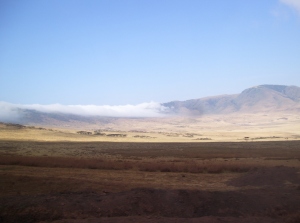These days, you can judge how well my day has gone by the number of times I’ve listened to “This Year” by the Mountain Goats – I’m going to make it through this year if it kills me. I haven’t even started applying to schools yet; it’s all been fellowships so far. As my next round of deadlines approaches, for the NSF Graduate Fellowship application, I’ve also been thinking near constantly about my trip this summer to Tanzania and Olduvai Gorge, with the “Soudoire Valley Song” as an appropriate soundtrack (see title). For the research proposal section of my application, I am designing a seismic survey of Olduvai Gorge and the surrounding basin. The proposal is mostly theoretical, a way for reviewers to see that you know how to properly approach and address a research problem, but the more work I do on this, the more I really want to make it a reality.
For a little background, Olduvai Gorge is a World Heritage Site in northern Tanzania that has yielded some of the most important paleoanthropological finds related to human origins in the 20th and 21st centuries. Some of the first researchers to take a close look at the gorge were Mary and Louis Leakey, who made such discoveries as a 2.6-1.7 million year old stone axe culture and the 1959 find of the Zinjanthropus boisei hominid skull. During his work at Olduvai, Louis Leakey started the career of the incomparable Jane Goodall, wanting someone to study chimpanzee behavior so that it could be used as a basis for conjecture about early hominid behavior. There was little time for sightseeing this summer, but if I’d had the time for a flight followed by a 3 hour water taxi ride, I’d have visited the Gombe Stream National Park, site of Dr. Goodall’s chimp observations and research center. Leakey also started Dian Fossey and Birute Galdikas on on their work with gorillas and orangutans for the same reason. Geologically, the Gorge is also a very important locale; located on the flank of the East African Rift where the continent is pulling apart, it contains layers of volcanic lavas and ash flows from the Ngorongoro Volcanic Highlands, which includes the world’s largest intact volcanic caldera, Ngorongoro Crater, and the active Oldoinyo Lengai volcano. Nearby at the site of Laetoli, there are actually fossil footprints of bipedal hominids preserved in the ash. Faulting and tectonic activity in the basin relates to the formation and expansion of the East African Rift.
You can see why I’d be excited about being there, and about the possibility of going back. Talking with a researcher who works on excavations in the gorge, it seems like there could be a lot of use for the type of project I want to do; a seismic survey would create a profile of rock layers up to 1 km deep in the subsurface, and it would provide a lot of information about the structure of the gorge and possibly determine new directions for excavation to take. As I’ve been doing the background research for my proposal, I keep realizing how little is actually known about the area, despite the better part of a century’s worth of field work. There has been little to no geophysical work in the area, except for the CRAFTI seismic array from this year, and none concentrating on the archaeology sites. Outlining this proposal has also made me do a lot of thinking about what I want out of graduate school and a research career; while I’m interested in the use of geophysics in archaeology, there is not a lot of work done by researchers in the US in that specific field. In the case of Olduvai, however, the intersection of geology and archaeology that the gorge provides, with its implications for continental rifting processes, rift related volcanics, and human origins, is a fascinating problem to delve into (and, hopefully, get funded by the NSF which technically doesn’t fund straight archaeology projects), and whether I get this fellowship or not I hope I can be back in the field there before too long. That’s the one good thing about having to write strict-3-page-limit-tell-us-everything-about-your-life-and-hopes-and-dreams-and-also-career-plans essays; I’m getting a much better grip on what’s important enough to go in them, and I think Olduvai Gorge is one of those things.
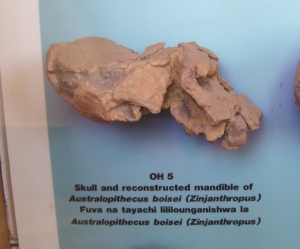
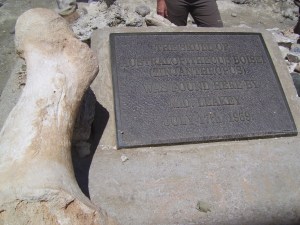
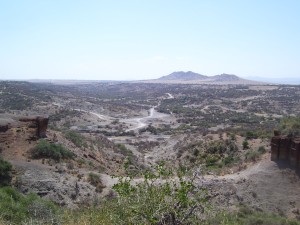
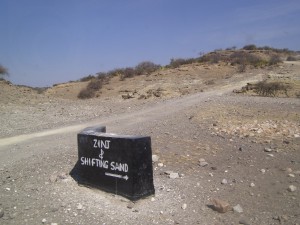
 The first two days of the trip were spent in the city of Arusha, taking care of the practicalities of heading into the field, not to mention adjusting to the new locale; while jetlag did not linger, nausea from taking antimalarial pills on an empty stomach did. While the drive west towards the survey area was ripe with new, incredible views and animal sitings, it was the first real day of work in the Ngorongoro Conservation Area that really brought home that I was on a whole new continent. Scattering baboons as we entered the park gates in the morning, we caught glimpses of the 100 square mile Ngorongoro Crater below in the mist as we drove around its rim. Our jeep bumped through patches of savannah and skirted the smaller yet still impressive crater Empakai, providing first sightings of the creatures that would become familiar parts of the landscape over the next 2 weeks, like zebra, ostriches, buffalo, and the slowly drifting herds of cows, goats, and sheep followed by their young Maasai herders. Finally, descending the slopes of Empakai, we came into the shadow of Ol Doinyo Lengai, the Mountain of God, and arrived at the seismic station housed there in a Maasai boma (village).
The first two days of the trip were spent in the city of Arusha, taking care of the practicalities of heading into the field, not to mention adjusting to the new locale; while jetlag did not linger, nausea from taking antimalarial pills on an empty stomach did. While the drive west towards the survey area was ripe with new, incredible views and animal sitings, it was the first real day of work in the Ngorongoro Conservation Area that really brought home that I was on a whole new continent. Scattering baboons as we entered the park gates in the morning, we caught glimpses of the 100 square mile Ngorongoro Crater below in the mist as we drove around its rim. Our jeep bumped through patches of savannah and skirted the smaller yet still impressive crater Empakai, providing first sightings of the creatures that would become familiar parts of the landscape over the next 2 weeks, like zebra, ostriches, buffalo, and the slowly drifting herds of cows, goats, and sheep followed by their young Maasai herders. Finally, descending the slopes of Empakai, we came into the shadow of Ol Doinyo Lengai, the Mountain of God, and arrived at the seismic station housed there in a Maasai boma (village). Ol Doinyo Lengai
Ol Doinyo Lengai


